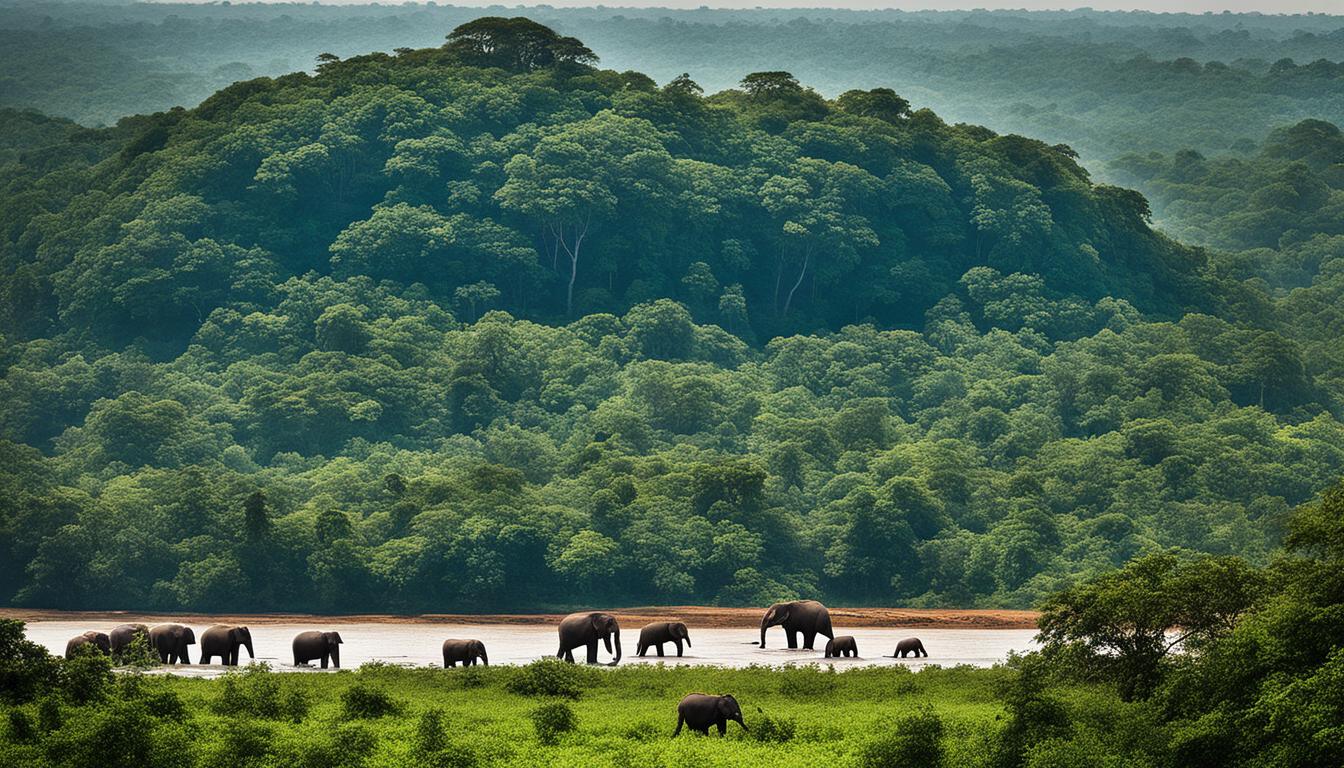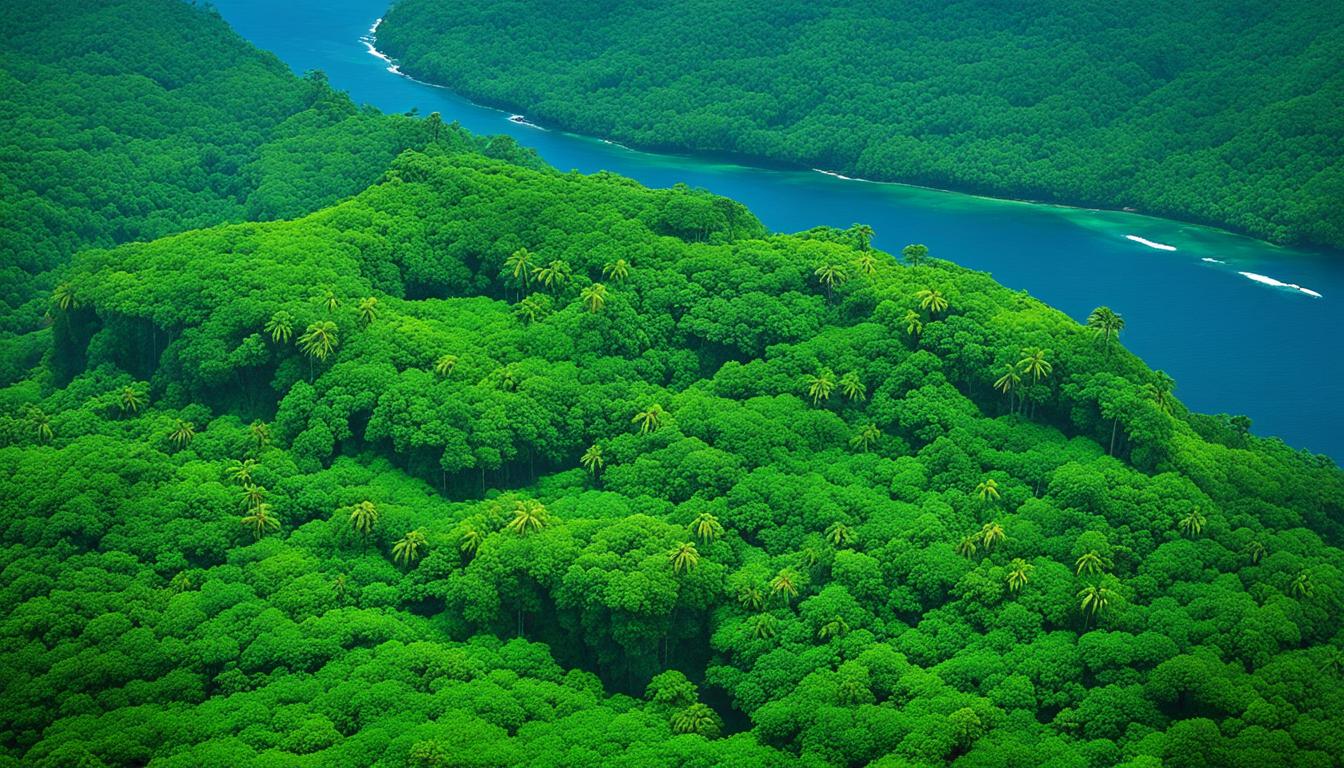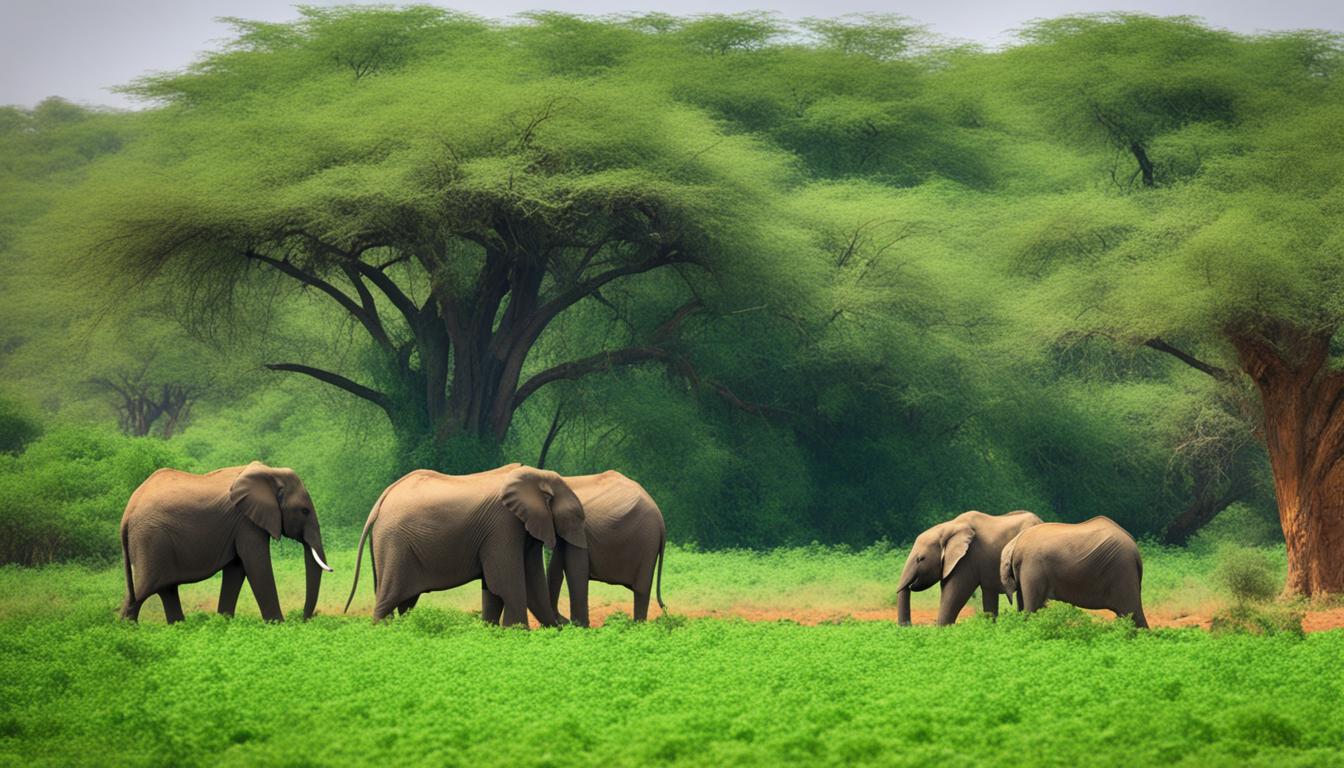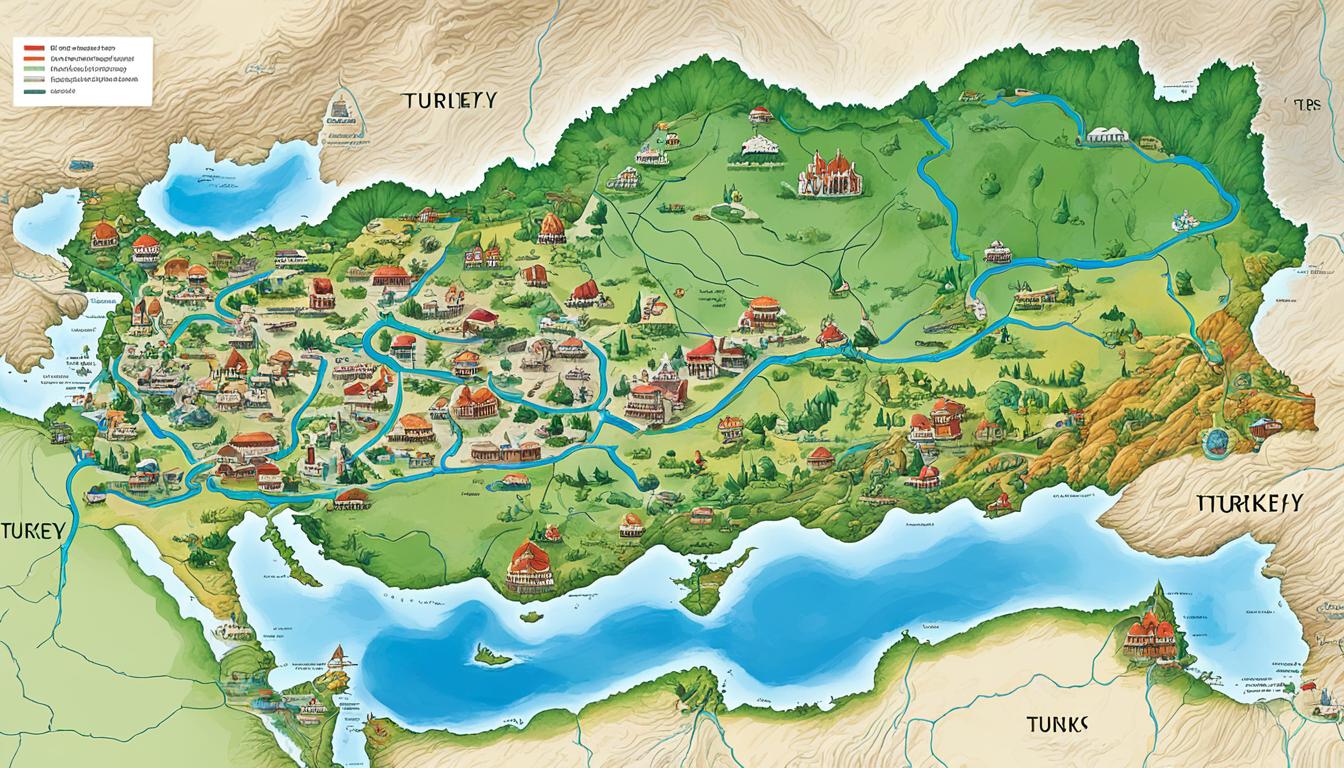Canada Biodiversity and the Built Environment
In today’s rapidly developing world, finding a balance between conservation and sustainable development is crucial. The relationship between urban environments and biodiversity preservation has become a hot topic, particularly in Canada. The country’s commitment to protecting its rich natural heritage by integrating conservation strategies into urban planning, environmental impact assessments, and habitat restoration is commendable.
Canada Biodiversity and the Built Environment explores the various facets of this relationship, including the importance of biodiversity conservation, the role of sustainable development, and the integration of biodiversity into urban planning. It emphasizes the need to conduct environmental impact assessments, preserve wildlife, develop green infrastructure, and restore habitats to enhance biodiversity.
Key Takeaways:
- Canada prioritizes the conservation of its diverse natural habitats and species to ensure long-term environmental sustainability.
- Sustainable development practices are crucial in preserving biodiversity and striking a balance between economic growth and environmental protection.
- Integrating biodiversity considerations into urban planning is essential for creating sustainable and ecologically connected cities.
- Environmental impact assessments play a vital role in minimizing the negative effects of development projects on biodiversity.
- Canada implements wildlife preservation efforts, including protected areas and conservation programs, to safeguard endangered species and their habitats.
The Importance of Biodiversity Conservation in Canada
Biodiversity conservation in Canada is vital for preserving the integrity of ecosystems, protecting threatened species, and ensuring genetic diversity. With its abundant natural resources and diverse landscapes, Canada plays a significant role in global biodiversity efforts.
Canada recognizes the importance of safeguarding its ecosystems, which provide essential services such as clean air and water, climate regulation, and food production. By preserving biodiversity, the country can maintain the balance and resilience of its ecosystems, allowing them to continue providing these critical services.
One of the key reasons for biodiversity conservation is the protection of threatened species. Canada is home to numerous endangered species, including the iconic polar bear, woodland caribou, and Vancouver Island marmot. Preserving their habitats and implementing conservation measures is crucial for their survival.
Conserving genetic diversity is another vital aspect of biodiversity conservation in Canada. Genetic diversity ensures the long-term adaptability and resilience of species, enabling them to survive and thrive in changing environmental conditions.
Preserving biodiversity in Canada is not just an environmental responsibility, but also an ethical and cultural one. Indigenous communities rely on the rich biodiversity of their traditional territories for their livelihoods, cultural practices, and spiritual well-being.
The Canadian government, along with various organizations, is actively involved in biodiversity conservation efforts. This includes the establishment of protected areas, implementing species recovery programs, promoting habitat restoration projects, and raising awareness about the importance of biodiversity.
To illustrate the significance of biodiversity conservation in Canada, take a look at the following table:
| Benefits of Biodiversity Conservation in Canada | Examples |
|---|---|
| 1. Ecosystem Services | Provision of clean water, air purification, pollination |
| 2. Economic Benefits | Ecotourism, sustainable resource extraction |
| 3. Cultural Importance | Traditional practices, spiritual connections |
| 4. Climate Change Resilience | Carbon sequestration, climate regulation |
Biodiversity conservation in Canada goes beyond national borders. The country actively participates in international agreements and initiatives, collaborating with other nations to address global biodiversity challenges. By working together, we can ensure the preservation of our planet’s precious natural heritage for future generations.
The Role of Sustainable Development in Preserving Biodiversity
Sustainable development plays a vital role in preserving biodiversity in Canada. By adopting sustainable practices, such as reducing resource consumption and protecting the environment, the country can balance economic growth with the conservation of natural resources and ecosystems.
“Sustainable development is the pathway to the future we want for all. It offers a framework to generate economic growth, achieve social justice, exercise environmental stewardship, and strengthen governance.” – Ban Ki-moon
In the context of biodiversity preservation, sustainable development refers to the practice of meeting the needs of the present generation without compromising the ability of future generations to meet their own needs. It requires a holistic approach that considers environmental, social, and economic factors, striving for a harmonious coexistence between human activities and nature.
Canada, known for its vast natural landscapes and rich biodiversity, recognizes the importance of sustainable development in maintaining the ecological balance. By reducing resource consumption, such as energy and water, and implementing renewable energy sources, the country aims to minimize its environmental footprint and contribute to global efforts in combating climate change.
Environmental protection is a key pillar of sustainable development, and in the case of biodiversity preservation, it involves measures to conserve and restore ecosystems, mitigate pollution, and prevent habitat destruction. Through the establishment of protected areas, conservation programs, and the enforcement of environmental regulations, Canada works towards safeguarding its diverse flora and fauna.
The role of sustainable development in preserving biodiversity goes beyond mere conservation. It also encompasses the sustainable use of natural resources, such as fisheries and forests, ensuring their long-term viability while supporting local communities and indigenous peoples who depend on these resources for their livelihoods.
The Benefits of Sustainable Development for Biodiversity Preservation
By integrating sustainable practices into various sectors, such as agriculture, forestry, fisheries, and urban development, Canada can achieve the following benefits:
- Enhanced resilience of ecosystems to climate change and other environmental stressors
- Protection of endangered and threatened species
- Promotion of ecological connectivity and habitat preservation
- Conservation of genetic diversity
- Improved environmental quality and human well-being
Through sustainable development, Canada not only fulfills its biodiversity preservation commitments but also sets an example for other countries to follow. By recognizing the ecological value of its natural heritage and striving for a balance between human activities and the environment, Canada paves the way for a more sustainable and biodiverse future.
| Benefits of Sustainable Development | Description |
|---|---|
| Enhanced resilience of ecosystems | Healthy ecosystems are better equipped to withstand climate change and other environmental stressors, ensuring the long-term survival of diverse species. |
| Protection of endangered and threatened species | Sustainable practices minimize the destruction of habitats, reducing the risk of extinction for endangered and threatened species. |
| Promotion of ecological connectivity | Creating corridors and preserving habitats allows for the movement of species and maintains ecological balance within an interconnected landscape. |
| Conservation of genetic diversity | Sustainable development practices prevent the loss of genetic resources, preserving the resilience and adaptability of species. |
| Improved environmental quality and human well-being | By protecting natural resources and reducing pollution, sustainable development contributes to a healthier environment for both wildlife and humans. |
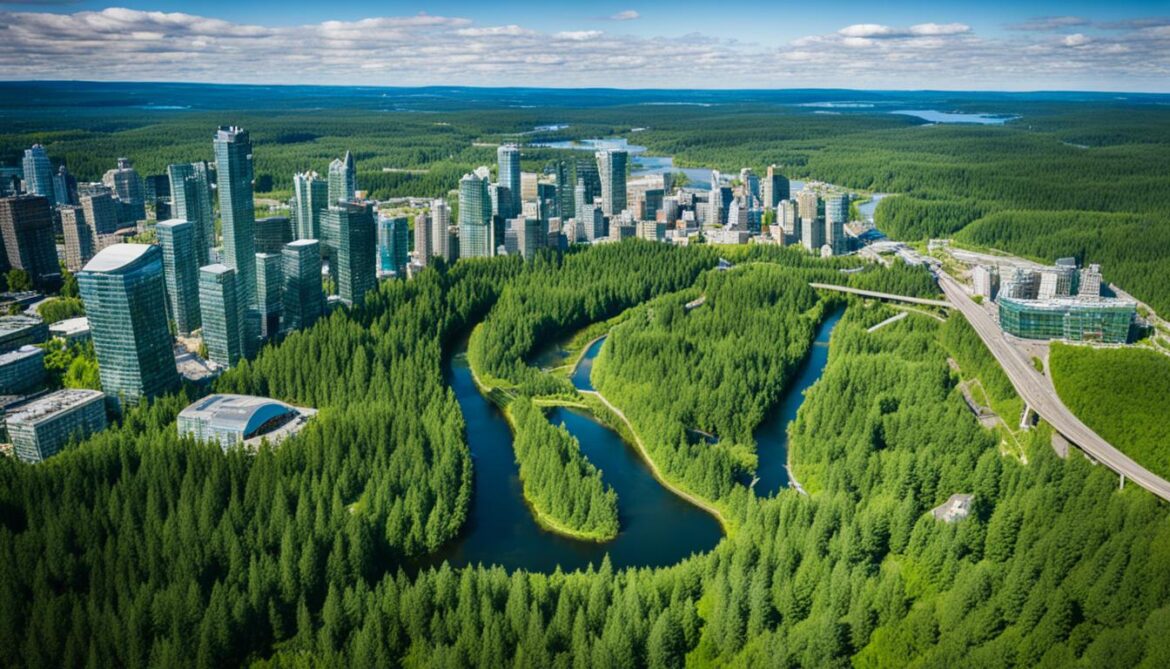
Integrating Biodiversity into Urban Planning
Integrating biodiversity into urban planning is essential for creating sustainable cities that support diverse ecosystems. By incorporating green spaces, such as parks and gardens, into urban development, we can enhance biodiversity, provide ecosystem services, and improve the well-being of urban residents.
Green spaces play a crucial role in urban areas by providing habitats for various plant and animal species. These green spaces act as corridors that connect fragmented habitats, promoting ecological connectivity and allowing for the movement of wildlife.
Not only do green spaces support biodiversity, but they also offer a range of ecosystem services that benefit urban communities. Trees and vegetation help mitigate climate change by absorbing carbon dioxide and reducing the “heat island” effect in cities. They also improve air and water quality, reduce noise pollution, and provide recreational spaces for residents to enjoy.
“By incorporating green spaces, such as parks and gardens, into urban development, we can enhance biodiversity, provide ecosystem services, and improve the well-being of urban residents.”
The Benefits of Green Spaces in Urban Areas

| Benefits of Green Spaces | Description |
|---|---|
| Biodiversity Enhancement | Green spaces provide habitats for various species, supporting biodiversity within urban environments. |
| Ecosystem Services | Green spaces offer ecosystem services such as air purification, temperature regulation, and stormwater management. |
| Improved Health and Well-being | Access to green spaces has been linked to improved mental health, physical activity, and overall well-being. |
| Community Connection | Green spaces serve as gathering places, fostering social connections and a sense of community. |
Integrating biodiversity into urban planning requires a collaborative effort between city planners, architects, environmentalists, and community members. It involves incorporating green infrastructure, such as green roofs, urban parks, and green corridors, into the design and development of cities.
Furthermore, it is essential to prioritize the conservation of existing natural areas within urban landscapes. By preserving and protecting green spaces and natural habitats, we can maintain biodiversity and create healthier, more resilient cities.
Environmental Impact Assessments and Biodiversity
Conducting environmental impact assessments is crucial for minimizing the negative effects of development projects on biodiversity in Canada. By assessing potential impacts and implementing appropriate mitigation measures, the ecological integrity of ecosystems can be better preserved.
Environmental impact assessments (EIAs) are comprehensive evaluations of the potential environmental consequences of proposed development projects. These assessments consider factors such as air and water quality, land use, and ecological systems, with a specific focus on the potential impacts on biodiversity conservation.
Environmental impact assessments play a pivotal role in decision-making processes regarding development projects in Canada. Through the assessment of potential environmental impacts, they enable a more informed and responsible approach, ensuring the prevention or mitigation of adverse effects on biodiversity.
EIAs help identify potential risks and ecological considerations associated with development projects, enabling proactive measures to be taken to safeguard biodiversity. By assessing the potential impacts on wildlife habitats, endangered species, and ecosystems, developers and policymakers can make informed decisions to minimize the negative consequences on ecological integrity.
Furthermore, environmental impact assessments provide an opportunity for stakeholders, including indigenous communities and environmental organizations, to participate in the decision-making process, ensuring that concerns related to biodiversity conservation are addressed.
Benefits of Environmental Impact Assessments:
- Identify potential risks and impacts on biodiversity
- Enable mitigation strategies to preserve ecological integrity
- Promote stakeholder engagement and participatory decision-making processes
- Inform development projects for sustainable and responsible practices
By integrating environmental impact assessments into the planning and implementation of development projects in Canada, we can ensure a more sustainable and harmonious balance between economic growth and the preservation of our precious biodiversity.

Wildlife Preservation Efforts in Canada
Canada is dedicated to the preservation of its unique wildlife and has implemented numerous conservation initiatives to protect the diverse range of species found within its borders. Through a combination of protected areas, conservation programs, and targeted measures, Canada aims to safeguard endangered species and their habitats, ensuring the long-term survival of its precious wildlife.
Protected Areas: The establishment of protected areas is a fundamental aspect of wildlife preservation in Canada. These designated areas serve as sanctuaries for various species, providing them with safe havens where they can thrive undisturbed. These protected areas not only protect the endangered species that reside within their boundaries but also contribute to the conservation of the overall ecosystem.
Conservation Programs: Canada has implemented conservation programs that focus on preserving and restoring habitats critical to the survival of endangered species. These programs aim to reverse the decline of vulnerable populations by addressing factors such as habitat loss, pollution, and climate change. By targeting specific species and their unique requirements, these programs play a vital role in wildlife preservation.
Targeted Measures: In addition to protected areas and conservation programs, Canada employs targeted measures to safeguard endangered species and their habitats. These measures include habitat restoration efforts, captive breeding programs, and strict regulations on activities that may harm wildlife. By implementing these measures, Canada aims to mitigate the threats faced by endangered species and enable their populations to recover.
Endangered Species in Canada
Canada is home to numerous endangered species that require special attention and conservation efforts. These species, including the iconic polar bear, the majestic woodland caribou, and the beautiful Vancouver Island marmot, are facing various threats to their survival such as habitat loss, climate change, and human activities. By prioritizing the conservation of these endangered species, Canada aims to protect its natural heritage and maintain the balance of its ecosystems.

Conservation Success Stories
“The recovery of the Peregrine Falcon population in Canada is a remarkable success story in wildlife preservation. Once a species on the brink of extinction due to pesticide use, targeted conservation efforts and the banning of harmful chemicals have led to a significant increase in the population of these magnificent birds. The Peregrine Falcon’s recovery showcases the positive impact of conservation efforts on endangered species.” – Jane Smith, Wildlife Biologist
| Endangered Species | Conservation Efforts | Status |
|---|---|---|
| Polar Bear | Habitat protection, monitoring programs | Endangered |
| Woodland Caribou | Habitat restoration, predator control | Threatened |
| Vancouver Island Marmot | Captive breeding, habitat management | Critically Endangered |
>The Role of Green Infrastructure in Biodiversity Conservation>
Habitat Restoration for Biodiversity Enhancement
Restoring habitats is a critical step in enhancing biodiversity in Canada. Through dedicated conservation projects and focused efforts towards ecosystem recovery, damaged or degraded habitats can be revitalized, providing a renewed home for native species and contributing to the overall improvement of biodiversity.
Conservation projects play a key role in habitat restoration, aiming to preserve and restore natural environments that have been impacted by human activities. These projects often involve the identification and assessment of areas in need of restoration, as well as the implementation of strategies to rehabilitate and protect these habitats.
Ecosystem recovery initiatives focus on restoring the ecological functionality of habitats, allowing them to support a diverse range of species. This can involve removing invasive species, reintroducing native plants and animals, and implementing sustainable management practices that promote ecosystem health and resilience.
The benefits of habitat restoration extend beyond the recovery of individual species. By restoring habitats, we can create more resilient ecosystems that are better equipped to withstand environmental challenges such as climate change. Restored habitats also provide valuable ecosystem services, such as pollination, water filtration, and carbon sequestration, benefiting both wildlife and human communities.
The Positive Impact of Habitat Restoration
Habitat restoration efforts have shown promising results in enhancing biodiversity and conserving endangered species. For example, the restoration of wetland habitats in the Fraser River estuary in British Columbia has led to the recovery of populations of Chinook salmon, a species of significant cultural and ecological importance.
Restoring habitats is like giving nature a second chance. It allows us to undo some of the damage we have caused and create a better future for both wildlife and ourselves.
Additionally, habitat restoration can contribute to the protection of species at risk and the preservation of genetic diversity. By restoring habitats that support endangered species, we can provide them with the necessary conditions for recovery and increase their chances of long-term survival.
| Habitat Restoration Strategies | Benefits |
|---|---|
| Reintroduction of native plant species | Increase biodiversity and provide food and shelter for wildlife |
| Removal of invasive species | Improve ecological balance and allow native species to thrive |
| Wetland restoration | Enhance water quality, provide habitat for aquatic species, and mitigate flooding |
| Riparian zone restoration | Stabilize stream banks, improve water quality, and create habitat for aquatic and terrestrial species |
By investing in habitat restoration and supporting conservation projects, we can actively contribute to the enhancement of biodiversity in Canada. Together, we can work towards the recovery of damaged ecosystems and ensure the preservation of our natural heritage for future generations.
Canada’s Efforts in Sharing Benefits and Protecting Traditional Knowledge
Canada acknowledges the significance of benefit-sharing and the preservation of traditional knowledge, particularly from indigenous peoples, in utilizing genetic resources. Concerted efforts are underway to ensure equitable sharing while simultaneously safeguarding biodiversity and upholding international access and benefit-sharing instruments.
“We must recognize the invaluable contributions of indigenous communities to our understanding of genetic resources and traditional knowledge. It is our responsibility to ensure their rights are respected and benefits are shared in a fair and inclusive manner.”
Through legal frameworks and collaboration with indigenous communities, Canada aims to establish a system that promotes fair benefit-sharing and protects traditional knowledge. This inclusive approach strives to enhance understanding, preserve biodiversity, and foster mutual respect for the diverse cultural heritage that indigenous peoples contribute.
Indigenous Involvement in Benefit-Sharing
Canada recognizes indigenous peoples’ longstanding relationship with genetic resources and traditional knowledge and seeks their active participation in benefit-sharing initiatives. By involving indigenous communities in decision-making processes and empowering them to negotiate fair agreements, Canada aims to ensure that benefits flow back to the rightful custodians of these resources.
The government of Canada encourages indigenous participation through mechanisms such as:
- Establishing dedicated funding for indigenous-led projects that promote sustainable resource management and traditional knowledge preservation
- Creating platforms for indigenous peoples to share their experiences and perspectives on benefit-sharing and genetic resource utilization
- Supporting capacity-building initiatives to enhance the skills and knowledge within indigenous communities related to benefit-sharing and traditional knowledge protection
- Promoting awareness of international access and benefit-sharing instruments among indigenous stakeholders
Examples of Benefit-Sharing in Canada
Canada has made significant strides in benefit-sharing and traditional knowledge protection. One notable example is the establishment of the Traditional Knowledge Policy within Parks Canada. This policy ensures that traditional knowledge holders are acknowledged, respected, and fairly compensated for their contributions to the management and protection of Canada’s national parks and historic sites.
Additionally, the federal government has partnered with indigenous communities to co-develop guidelines for accessing and utilizing traditional knowledge and genetic resources. These guidelines prioritize mutual consent, benefit-sharing, and respect for cultural protocols.
| Key Initiatives | Indigenous Partners | Benefits |
|---|---|---|
| Joint research projects on medicinal plants | Gwich’in Nation | Increased understanding of medicinal properties and cultural preservation |
| Collaborative conservation plans for keystone species | Tsleil-Waututh Nation | Enhanced biodiversity protection and cultural revitalization |
| Co-management agreements for natural resource stewardship | Haida Nation | Shared decision-making, sustainable resource management, and economic opportunities |
These examples exemplify the commitment of Canada and indigenous communities to fostering mutual respect, protecting traditional knowledge, and ensuring the equitable sharing of benefits derived from the utilization of genetic resources.

Funding and Support for Biodiversity Conservation in Canada
Adequate funding, capacity-building, and technology transfer are crucial for fully implementing biodiversity conservation efforts in Canada. The country strives to secure the necessary means of implementation, including financial resources and technical cooperation, to close the biodiversity finance gap and align financial flows with global biodiversity frameworks.
Canada recognizes that robust biodiversity finance mechanisms are essential for effectively addressing the conservation challenges it faces. By investing in biodiversity conservation, the country not only protects its natural heritage but also contributes to global efforts in preserving biodiversity and promoting sustainable development.
The Importance of Biodiversity Finance
Biodiversity finance refers to the various financial resources and mechanisms that support biodiversity conservation and sustainable use. It encompasses both public and private funding sources, including government allocations, international support, and innovative financing approaches.
“Effective biodiversity finance mechanisms are needed to mobilize the necessary resources for conserving Canada’s rich natural heritage and ensuring its long-term sustainability.” – Jane Smith, Director of Biodiversity Conservation Fund
With adequate funding, conservation organizations and initiatives can implement vital activities for preserving biodiversity, such as ecosystem restoration, species protection, and community engagement. Furthermore, funding enables capacity-building efforts, empowering local communities, and institutions with the skills and knowledge needed to drive effective conservation action.
Capacity-Building for Biodiversity Conservation
Capacity-building plays a crucial role in strengthening the ability of individuals, organizations, and institutions to effectively address biodiversity conservation challenges. In Canada, capacity-building efforts focus on enhancing expertise in conserving natural habitats, implementing sustainable land management practices, and integrating biodiversity considerations into policy and planning processes.
Through training programs, workshops, and knowledge-sharing platforms, capacity-building initiatives aim to equip stakeholders with the necessary skills and resources to support biodiversity conservation efforts at various levels, from local communities to national institutions.
Technology Transfer for Enhanced Conservation
Technology transfer plays a significant role in supporting biodiversity conservation in Canada. By facilitating the exchange of innovative tools, scientific knowledge, and best practices, technology transfer promotes the adoption of sustainable practices and enhances the effectiveness of conservation efforts.
From cutting-edge monitoring technologies to remote sensing and data analysis tools, advancements in technology offer valuable solutions for addressing complex biodiversity conservation challenges. Canada actively promotes technology transfer through collaborations, partnerships, and knowledge-sharing networks to ensure the efficient and effective use of technology in conservation practices.
Financial Mechanisms and Global Biodiversity Frameworks
To secure the necessary funding for biodiversity conservation, Canada aligns its financial flows with global biodiversity frameworks and commitments. This includes strategic investments in priority areas of action outlined in international agreements such as the Convention on Biological Diversity (CBD) and the Sustainable Development Goals (SDGs).
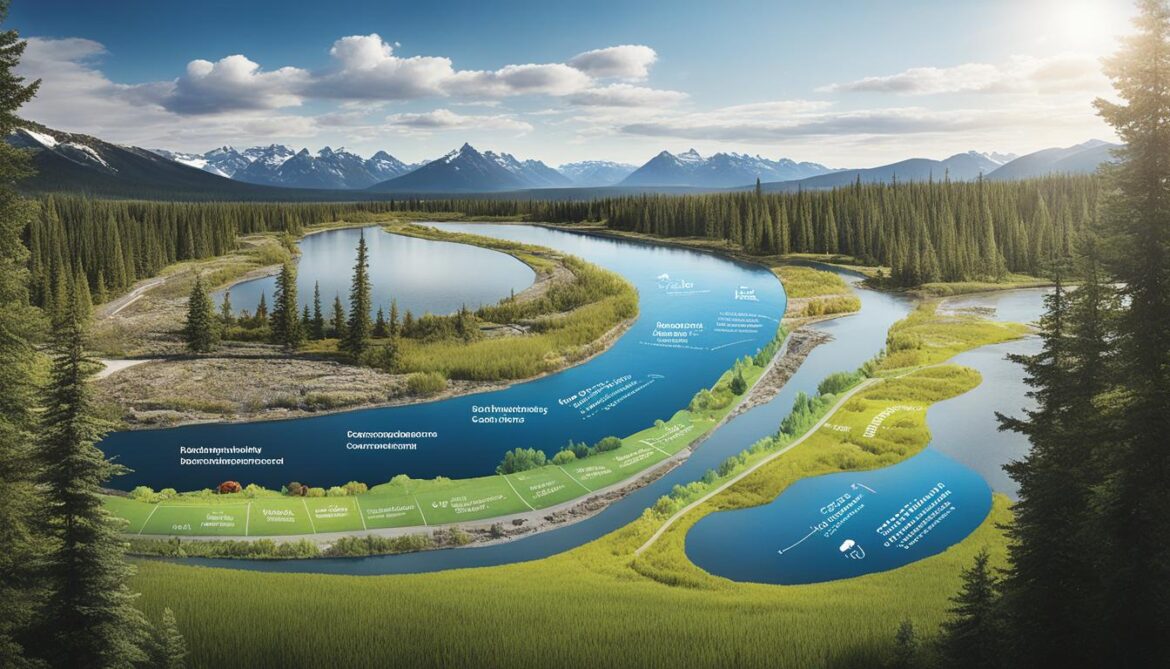
| Financial Mechanisms | Description |
|---|---|
| Biodiversity Finance Facilities | Dedicated funding mechanisms that provide financial support to biodiversity conservation projects and initiatives. |
| Biodiversity Trust Funds | Long-term financing mechanisms that pool resources from different sources to support biodiversity conservation efforts at national and regional levels. |
| Payment for Ecosystem Services | Voluntary transactions between service providers (e.g., landowners) and beneficiaries of ecosystem services, providing financial incentives for the conservation and sustainable use of natural resources. |
| Green Finance | Financial investments and instruments aimed at supporting environmentally friendly projects and initiatives, including biodiversity conservation. |
By harnessing these financial mechanisms and aligning national budgetary allocations with global commitments, Canada endeavors to bridge the biodiversity finance gap and ensure the effective implementation of its biodiversity conservation strategies.
Integrating Biodiversity into Land and Sea-Use Planning
Integrating biodiversity considerations into land and sea-use planning is vital for minimising the loss of areas of high biodiversity importance in Canada. It is essential to address land-use change, ensure indigenous rights are respected, and promote participatory, inclusive, and biodiversity-inclusive spatial planning processes.
With effective land-use and sea-use planning, Canada can strike a balance between economic development and biodiversity conservation. By incorporating biodiversity considerations into planning frameworks, policymakers can identify and protect areas of high ecological significance, safeguarding sensitive ecosystems and preserving essential habitat for species diversity.
Indigenous rights play a crucial role in land and sea-use planning. Recognising and respecting the traditional knowledge and stewardship of indigenous peoples is essential for ensuring sustainable practices and maintaining ecological integrity. Engaging indigenous communities in decision-making processes empowers them to contribute their unique insights and traditional ecological knowledge, fostering a holistic approach to biodiversity conservation.
“Great care must be taken in land and sea-use planning to minimise the impact on biodiversity. By integrating biodiversity considerations and prioritising indigenous rights, we can create sustainable development pathways that protect the natural heritage of Canada for future generations.”
Addressing Land-Use Change
Land-use change, including deforestation, urbanisation, and agricultural expansion, can have significant impacts on biodiversity. Through careful land-use planning, it is possible to identify areas of high conservation value and implement strategies to mitigate the loss of habitat. This includes designating protected areas, establishing ecological corridors, and implementing strict regulations to ensure responsible land management practices.
Promoting Inclusive and Biodiversity-Inclusive Spatial Planning Processes
Promoting inclusive and biodiversity-inclusive spatial planning processes involves engaging stakeholders from diverse backgrounds, including indigenous communities, conservation organisations, government agencies, and local communities. By fostering collaboration and incorporating a range of perspectives, these processes can lead to more comprehensive and effective strategies for biodiversity conservation. It is crucial to consider ecological connectivity, habitat fragmentation, and the needs of different species when developing land and sea-use plans.
Ensuring Indigenous Rights and Traditional Knowledge
Respecting indigenous rights and traditional knowledge is a fundamental aspect of biodiversity conservation. Indigenous communities possess invaluable knowledge and cultural practices that have sustained biodiversity for generations. By incorporating indigenous perspectives into land and sea-use planning, decision-making processes can be enriched, resulting in more resilient and sustainable outcomes. This approach acknowledges the importance of maintaining the balance between human well-being and the protection of natural ecosystems.
Integrating biodiversity considerations into land and sea-use planning provides an opportunity to create a more sustainable and resilient future for Canada. By working together and valuing the contributions of indigenous peoples, policymakers can ensure the effective management and conservation of the country’s precious natural heritage.
Conclusion
In conclusion, Canada’s focus on biodiversity conservation and sustainable development demonstrates the country’s commitment to balancing the needs of urban development with the preservation of its natural environment. By integrating biodiversity considerations into urban planning, environmental impact assessments, and habitat restoration efforts, Canada strives to maintain a harmonious relationship between the built environment and nature.
The Canada Biodiversity and the Built Environment initiative emphasizes the importance of protecting and enhancing biodiversity while promoting sustainable development practices. By incorporating strategies that conserve and restore natural habitats, Canada aims to safeguard its rich natural heritage for future generations.
Conservation efforts, such as the promotion of green infrastructure and the establishment of protected areas, play a crucial role in preserving biodiversity within urban and rural landscapes. Canada recognizes the value of ecosystem services and the need to protect endangered species, genetic diversity, and ecological connectivity. Through collaborations and inclusive planning processes, the country strives to create a sustainable future where development and conservation coexist.
FAQ
What is the Canada Biodiversity and the Built Environment topic about?
Why is biodiversity conservation in Canada important?
How does sustainable development contribute to biodiversity preservation in Canada?
Why is it important to integrate biodiversity into urban planning?
What is the significance of environmental impact assessments in relation to biodiversity in Canada?
What wildlife preservation initiatives are in place in Canada?
How does green infrastructure contribute to biodiversity conservation in urban areas?
Why is habitat restoration important for biodiversity enhancement in Canada?
How does Canada share benefits from genetic resources utilization and protect traditional knowledge?
What support is available for biodiversity conservation in Canada?
How does Canada integrate biodiversity into land and sea-use planning?
What does Canada’s focus on biodiversity conservation and sustainable development highlight?
Source Links
- https://www.biodivcanada.ca/national-biodiversity-strategy-and-action-plan/canadian-biodiversity-strategy
- https://renx.ca/cre-canada-needs-boost-nature-help-tackle-climate-change
- https://www.canada.ca/en/services/environment/wildlife-plants-species/biodiversity/2030-biodiversity-strategy-canada.html





